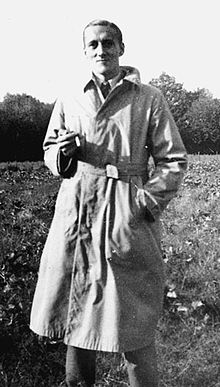

Queer Places:
Bedales School, Church Rd, Steep, Petersfield GU32 2DG, UK
University of Oxford, Oxford, Oxfordshire OX1 3PA
 Jocelyn
Brooke (30 November 1908 – 29 October 1966) was an English author born in
Kent. He wrote several unique, semi-autobiographical novels, as well as some
poetry. His most famous works include the Orchid Trilogy—The Military
Orchid (1948), A Mine of Serpents (1949), and The Goose
Cathedral (1950)—and The Image of a Drawn Sword (1950). The coining
of the expression ‘Homintern’ is often attributed to
Cyril Connolly, less often to
Maurice Bowra, and sometimes to
W.H. Auden; but
Anthony Powell thought its
source was Jocelyn Brooke, and
Harold Norse claimed it for himself.
Jocelyn
Brooke (30 November 1908 – 29 October 1966) was an English author born in
Kent. He wrote several unique, semi-autobiographical novels, as well as some
poetry. His most famous works include the Orchid Trilogy—The Military
Orchid (1948), A Mine of Serpents (1949), and The Goose
Cathedral (1950)—and The Image of a Drawn Sword (1950). The coining
of the expression ‘Homintern’ is often attributed to
Cyril Connolly, less often to
Maurice Bowra, and sometimes to
W.H. Auden; but
Anthony Powell thought its
source was Jocelyn Brooke, and
Harold Norse claimed it for himself.
Educated at Bedales (after escaping twice from a public school) and Worcester College, Oxford, Brooke's childhood revolved mostly around his principal interests of amateur botany and fireworks, in the shadow of the First World War. "When the Second World War began he enlisted in the Royal Army Medical Corps (RAMC) and became one of the pox wallahs, those working to treat venereal disease. Brooke was decorated for bravery."[1] Elements of his experiences, and his love of the military life, appear in most of his subsequent works.
Though the Orchid Trilogy strays into a typically English vein of humour, the idyllic land of his childhood and his obsession with le paradis perdu often bring in an element of intense melancholy, something developed in paranoia and isolation in The Image of a Drawn Sword.
The old Seabrook Lifeboat station, which is the defining symbol of the third novel in Brooke's Orchid Trilogy, was turned into the Boathouse Café in the 1930s. It is described thus at the end of the book: It was a grey, chilly evening, threatening rain; by the time I reached the bottom of Hospital Hill, it was quite dark. Dimly-lighted, the Goose Cathedral loomed through the blackness; I crossed the road, and approached the back entrance, facing towards the camp. A small conservatory or 'winter garden', like some salvaged fragment of the Crystal Palace, had been built on to this side ...
In the faint electric light, the interior of the café seemed enormous, barn-like...down the sides of the room were placed an number of solid, mahogany tables: the light gleamed vaguely on their polished surfaces...I realized that I was sitting, at last, beneath the roof of the Goose Cathedral - that sinister and sacrosanct chapel-by-the-sea where, in my childhood, the enormous blue-and-red lifeboat had couched, mysteriously, like a sea-monster in its lair.
My published books: